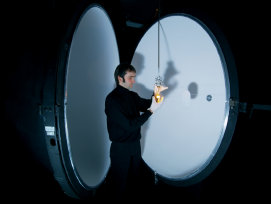Luminous Flux
The radiation power of a light source weighted according to the perception of brightness in the human eye is called luminous fluxF. It comprises the total radiation of a light source emitted into space. The unit of luminous flux is the lumen (lm) (lumen, Latin: light).

The realization of the lumen is carried out by standard lamps at BEV, the luminous flux of which is calibrated regularly by the Physikalisch-Technischen Bundesanstalt (PTB, Germany). The luminous flux of a source is measured by an Ulbricht sphere (Integrating sphere). This instrument is a hollow sphere in the middle of which the light source is installed. The inner side of the hollow sphere is especially coated by a white layer, in order to guarantee an as complete as possible dispersive reflection of light. A photometer (see: luminous intensity) is connected to the hollow sphere. If an aperture prevents, that the light of the source hits the photometer directly, the luminous intensity measured is proportional to the luminous flux of the source.
The proportional factor is essentially a function of the geometry and the configuration of the sphere.